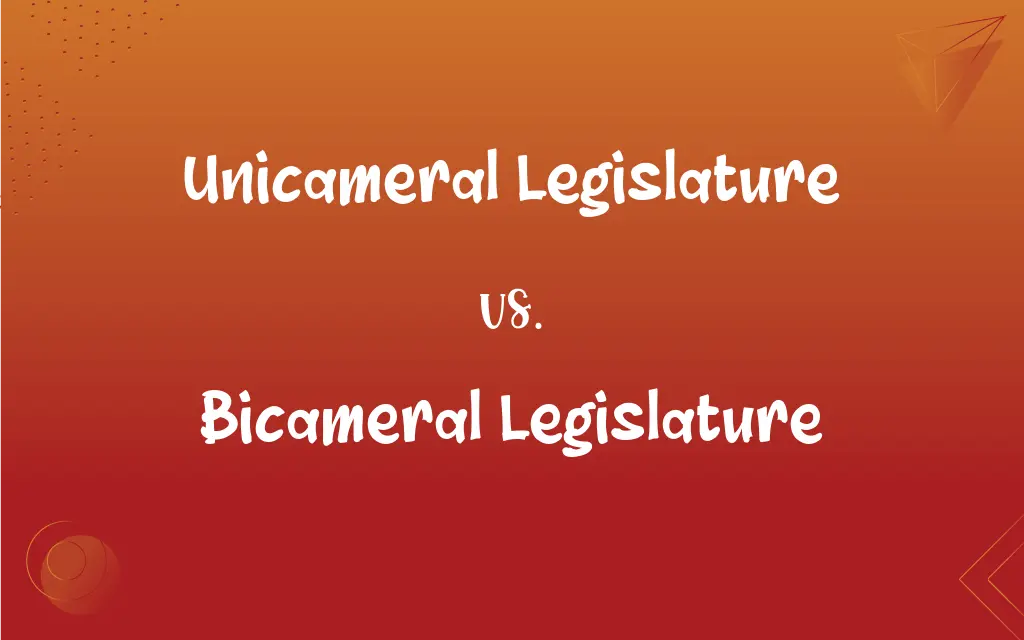Unicameral Legislature vs. Bicameral Legislature: What's the Difference?
Edited by Janet White || By Harlon Moss || Updated on October 11, 2023
Unicameral legislature involves a single legislative body, while bicameral legislature consists of two separate chambers, typically representing different segments of the society.

Key Differences
The unicameral legislature indicates a legislative approach that funnels decision-making and law-passing through a singular body or chamber. Every member, representing a specific constituency or group, participates in a collective manner to create, assess, and implement legislation. The simplicity and straightforwardness of the unicameral system tend to lead to swift decision-making and legal processes. Furthermore, with a unicameral legislature, there is a clear, unambiguous process, and laws are less likely to be stymied by inter-chamber disagreements.
Bicameral legislature, contrarily, operates with two distinct chambers or houses, each possessing its unique mandates and roles in the legislative process. These chambers, often titled as the lower and upper house, endeavor to ensure a balanced representation of diverse societal factions, safeguarding against the dominance of a single group. These chambers may have varied capacities and powers, such as representing different regions or classes, or handling different kinds of legislation, which can help ensure that enacted laws have undergone thorough scrutiny.
In a unicameral legislature, the potential for rapid enactment of laws resides. A single house means a single debate, and once a consensus (or majority) is attained, a law can be enacted. This ensures that legislative processes are not protracted and allows for more direct governance. However, critics often point out that this speed and efficiency can sometimes lead to insufficiently debated laws and potentially allow for the dominance of a particular group or interest in the legislative process, especially if they hold a substantial majority.
With a bicameral legislature, an in-built mechanism for check and balance is inherent, often providing a stabilizing effect on the legal and political system. The existence of two chambers necessitates the concurrence of both bodies to pass legislation, which means laws are typically subjected to rigorous debate and scrutiny. This can safeguard against hasty decisions and enforce a systematic check on legislative power. Conversely, this can also lead to legislative gridlock if the two houses are unable to agree on particular issues.
Both unicameral and bicameral legislatures offer distinct advantages and disadvantages related to efficiency, representation, and checks and balances. A unicameral legislature may be apt for nations that prioritize swift decision-making and have homogenous demographics. Conversely, bicameral structures might serve nations well where there's a wide array of interests and a necessity to offer balanced representation to diverse groups. Thus, the choice between unicameral and bicameral often hinges on a nation’s size, diversity, and philosophical approach to governance.
ADVERTISEMENT
Comparison Chart
Number of Chambers
One
Two
Decision-making Speed
Typically faster due to a singular decision-making body.
Slower, as legislation must pass through two separate chambers.
Representation
Represents all constituencies in a single body.
Divides representation between two houses, often by different criteria.
Checks and Balances
Limited internal checks and balances within the legislature.
Provides intrinsic checks and balances through two chambers.
Complexity
Simpler, more straightforward structure and processes.
More complex, with additional processes and potential for disagreement between chambers.
ADVERTISEMENT
Unicameral Legislature and Bicameral Legislature Definitions
Unicameral Legislature
A unicameral legislature is a law-making body with a single chamber.
Nebraska employs a unicameral legislature to simplify its legislative process.
Bicameral Legislature
Bicameral legislatures enforce a dual-step process for passing laws.
In a bicameral legislature, a proposed law must gain approval from both chambers to be enacted.
Unicameral Legislature
Unicameral systems are typically adopted for their simplicity and speed.
The country chose a unicameral legislature to expedite its decision-making.
Bicameral Legislature
Bicameral legislatures offer intrinsic checks and balances in law-making.
Critics appreciate the bicameral legislature for preventing hasty enactment of laws due to its double-layered scrutiny.
Unicameral Legislature
Unicameral legislatures tend to have unidimensional checks and balances.
Critics argue that the unicameral legislature lacks sufficient internal scrutiny.
Bicameral Legislature
In a bicameral system, each chamber may have different powers and functions.
In the UK, the bicameral legislature assigns distinct responsibilities to the House of Commons and the House of Lords.
Unicameral Legislature
Unicameral legislatures can make decisions with a single majority vote.
The unicameral legislature passed the law with a straightforward majority.
Bicameral Legislature
A bicameral legislature consists of two separate chambers or houses.
The United States employs a bicameral legislature, comprising the Senate and the House of Representatives.
Unicameral Legislature
All legislative members are housed in one assembly in a unicameral system.
Every representative in the unicameral legislature debated the new policy vociferously.
Bicameral Legislature
The bicameral system typically represents different constituencies in each chamber.
The bicameral legislature ensures various groups, like states and the general populace, have distinct representation.
FAQs
What is the purpose of having a bicameral legislature?
A bicameral legislature aims to provide diverse representation and facilitate thorough checks and balances in the law-making process.
How does a bicameral legislature function?
A bicameral legislature functions with two separate chambers, each passing laws through independent processes before synchronization.
How are members of a unicameral legislature typically selected?
The selection process varies, involving either direct elections, appointments, or a combination thereof, depending on the country.
Are all unicameral legislatures similar in structure?
No, the structure and operational mechanics of unicameral legislatures can vary widely based on country and legal frameworks.
What is a unicameral legislature?
A unicameral legislature is a governing body with a single legislative chamber.
Why might a country choose a unicameral system?
A country might choose a unicameral system for its simplicity, cost-effectiveness, and swift decision-making.
Are unicameral legislatures more common in smaller countries?
Yes, smaller countries often prefer unicameral legislatures due to their straightforward administration and lower operational costs.
Can a unicameral legislature represent diverse interests adequately?
Critics argue it may struggle to do so compared to bicameral systems, but advocates note its directness and representational clarity.
How does a bill become law in a bicameral system?
A bill must typically be approved by both chambers independently before becoming law in a bicameral system.
Is a unicameral legislature cheaper to run than a bicameral one?
Generally, yes—unicameral legislatures tend to incur lower operational costs due to having a singular chamber and fewer representatives.
Which countries are examples of using a unicameral legislature?
Examples include Finland, Sweden, and New Zealand, all of which employ a unicameral legislative system.
Is it common for a nation to change from a bicameral to a unicameral system, or vice versa?
It's not common and typically involves significant constitutional changes, but it has occurred in response to shifts in political philosophies and structures.
Are bicameral legislatures inherently better at representing diverse interests?
Not inherently, but their dual-chamber structure allows them to represent varied constituencies or interests in different ways.
What are the potential downsides of a unicameral legislature?
Critics mention potential downsides like insufficient checks and balances and the potential for majority dominance.
Do both chambers in a bicameral legislature hold equal power?
Not always—different countries allocate varied powers and responsibilities between the two chambers.
Can a bicameral legislature cause governmental gridlock?
Yes, differing opinions between the two chambers in a bicameral system can sometimes lead to legislative standstills.
How are the two chambers of a bicameral legislature typically differentiated?
They are often differentiated by name, representation type, power dynamics, and legislative responsibilities.
Which countries utilize a bicameral legislative system?
Countries like the United States, the United Kingdom, and India utilize a bicameral legislative system.
About Author
Written by
Harlon MossHarlon is a seasoned quality moderator and accomplished content writer for Difference Wiki. An alumnus of the prestigious University of California, he earned his degree in Computer Science. Leveraging his academic background, Harlon brings a meticulous and informed perspective to his work, ensuring content accuracy and excellence.
Edited by
Janet WhiteJanet White has been an esteemed writer and blogger for Difference Wiki. Holding a Master's degree in Science and Medical Journalism from the prestigious Boston University, she has consistently demonstrated her expertise and passion for her field. When she's not immersed in her work, Janet relishes her time exercising, delving into a good book, and cherishing moments with friends and family.
































































